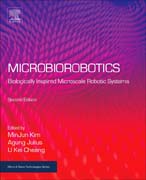
Microbiorobotics: Biologically Inspired Microscale Robotic Systems
Kim, Minjun
Julius, Anak Agung
Cheang, U Kei
Microbiorobotics: Biologically Inspired Microscale Robotic Systems, Second Edition presents information on a new engineering discipline that takes a multidisciplinary approach to accomplish precise manipulation of microscale spaces. Microorganisms have evolved various mechanisms to thrive in microscale environments and are therefore a useful tool for use in many applications, ranging from micromanufacturing techniques, to cellular manipulation. In the context of microrobotics, biological microrobots can directly harness the microorganisms for propulsive and sensing power and synthetic microrobots can mimic the microorganisms' motions for effective locomotion. This second edition covers new advances and insights that have emerged in recent years. Several new chapters have been added on important new research areas, with existing chapters thoroughly revised. In particular, increased coverage is given to fluid dynamics of microswimmers in nature. Gives the reader an understanding of the fundamental changes in dynamics and fabrication techniques in the microenvironmentOffers a unique two-pronged approach to microrobotics from a biological perspective, i.e. bioinspired engineering design of biological systems to accomplish engineering tasksIntroduces an interdisciplinary readership to the toolkit that micro-organisms offer to micro-engineering INDICE: A: IntroductionA.1: Why microbioroboticsA.2: Motivation for microbioroboticsA.3: Historical overviewB: Microorganisms in Motion at Low Reynolds NumberB.1: Bacterial Swarming(Dr, Doug Weibel at the University of Wisconsin)B.2: Bacterial Swimming(Dr. Jeffrey Guasto at Tufts University and Dr. Roman Stocker at MIT)B.3: Paramecium in Motion(Dr. Sunghwan (Sunny Jung) at Virginia Tech)B.4: C. elegans in Motion(Dr. Paulo Arratia at the University of Pennsylvania)C: Biological MicrorobotsC.1: Control of Bacterobots(Dr. Jongoh Park and Dr. Sukho Park at Chonnam National University)C.2: Control of Magnetotatic Bacteria(Dr. Sarthak Misra at the University of Twente)C.3: Control of Artificial Magnetotactic Tetrahymena pyriformis(Dr. Min Jun Kim at Drexel University and Dr. Agung Julius at Rensselaer Polytechnic Institute)C.4: Control of Bacteria-Powered Microrobots for Obstacle Avoidance(Dr. Min Jun Kim at Drexel University and Dr. Agung Julius at Rensselaer Polytechnic Institute)C.5: Engineering Bacteria for Microrobots: a Synthetic Biology Perspective(Dr. Cynthia Collins at Rensselaer Polytechnic Institute)D: Synthetic MicrorobotsD.1: Control of Artificial Flagella(Dr. Bradley Nelson at ETH Zurich)D.2: Control of Microrobots in Viscoelastic Fluids(Dr. Peer Fischer at Max Planck Institute for Intelligence Systems)D.3: Control of Three Bead Achiral Robotic Microswimmers(Dr. Min Jun Kim at Drexel University, Dr. Dejan Milutinovic at the University of California, Santa Cruz, and Dr. Jongeun Choi at Michigan State University)D.4: Control of Magnetic Microrobots(Dr. Metin Sitti at Carnegie Mellon University)E: Perspectives and Outlook
- ISBN: 978-0-323-42993-1
- Editorial: Elsevier
- Encuadernacion: Cartoné
- Páginas: 384
- Fecha Publicación: 09/01/2017
- Nº Volúmenes: 1
- Idioma: Inglés
